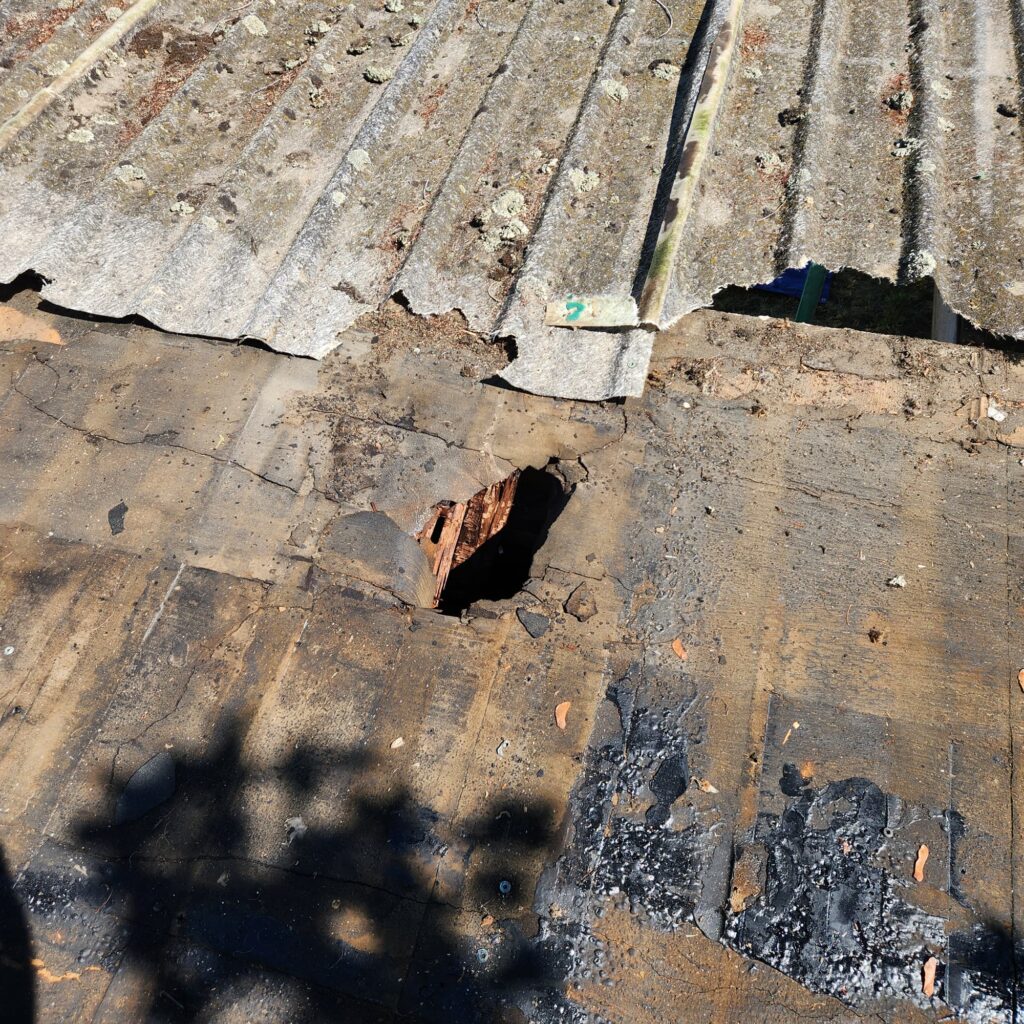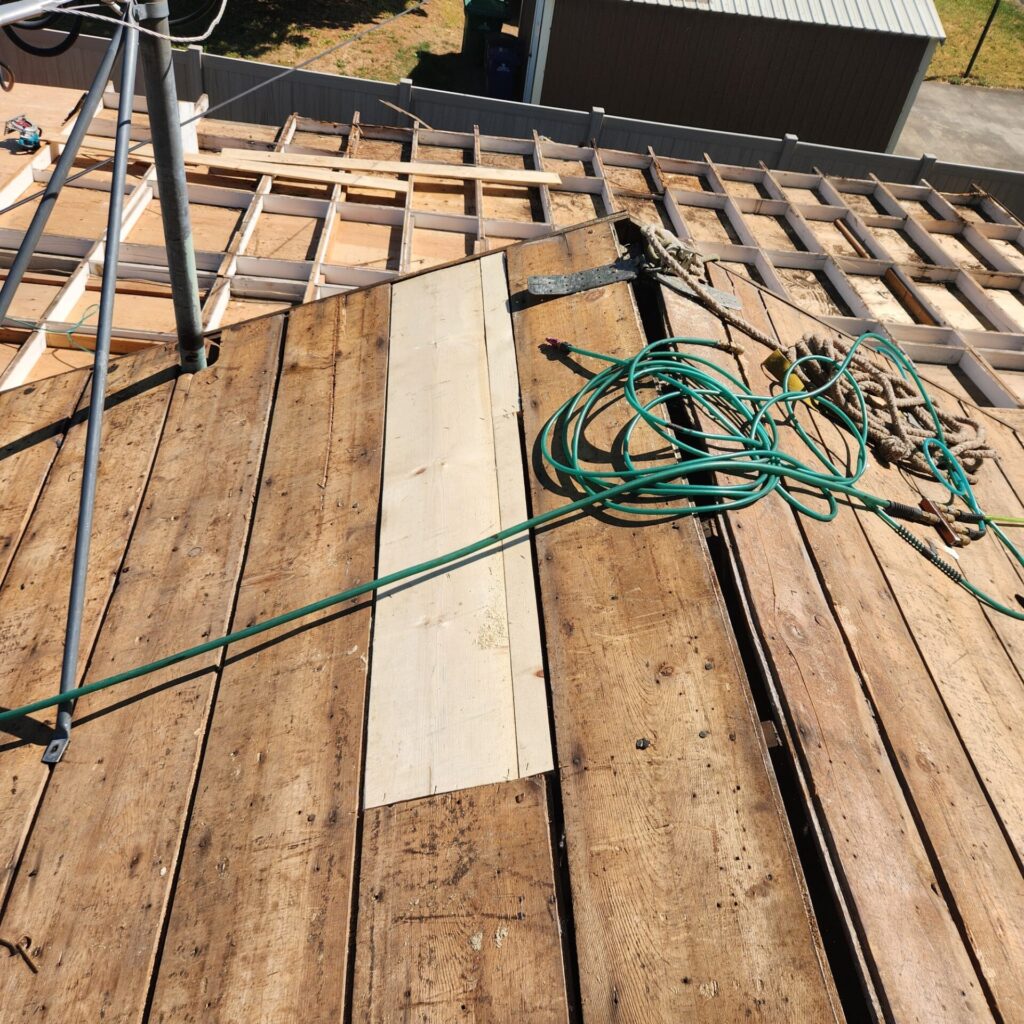High winds can wreak havoc on homeowners’ roof shingles, leading to leaks and costly repairs if the damage is not caught early. Be sure to always stay one step ahead of costly damages.
Our team will guide you through seven clear signs of identifying wind damage, demonstrate how to patch and repair your roof, explain how to select wind-rated shingles, and assist you in determining when to hire professionals.
Signs of Wind Damage on Your Roof Shingles
Even low wind speed can cause significant wind damage to roof shingles and it often starts small but can quickly lead to major leaks if left unchecked. Below are seven key warning signs, each covering the underlying cause, its appearance on your roof, and the worst-case outcome if left unaddressed.
1. Missing or Displaced Shingles
Strong gusts lift the edges of shingles and can pry them entirely off the deck. You may find pieces in your yard or see bare spots where shingles once covered the underlayment. When a shingle is gone, rain can fall directly onto the felt and wood below, leading to rot in the decking beneath.
Over time, that moisture will seep into your attic, damaging insulation and potentially causing ceiling stains. Noticing a few missing shingles today could save you from storm damage, a leaking attic, costly structural repairs, and mold growth later.
To be sure, ask yourself:
- Have you spotted shingles on the ground after the last storm?
- Do any roof sections look patchy or darker than the rest?
If the answer is yes, it’s definitely time to replace those missing pieces, and do it fast.
2. Lifted or Curling Shingle Tabs (Creased Shingle)
Wind often slips under shingle tabs, bending them upward and breaking the seal. You’ll see edges that curl away from the roof surface or small ridges where the shingle has folded back. Once raised, a shingle acts like a sail, catching the next gust until it tears away.
Meanwhile, water seeps under the lifted edge, softening the underlayment and causing repeated leaks. If left unaddressed, those leaks can weaken your roof’s framework and lead to extensive interior damage.
Think about it:
- Do any shingle corners pop up when you run your hand along the roof?
- Can you spot folded layers or small ridges in your shingles?
3. Granule Loss in Gutters
Shingles are coated with mineral granules to protect the asphalt core from the sun and rain. High winds and driving rain strip these granules off, and you’ll find dark, sand-like grit in your gutters and downspouts.
Without granules, shingles lose their UV barrier and wear out rapidly, becoming brittle and prone to cracking. As more granules wash away, the roof ages prematurely and may need full roof replacement years earlier than expected.
Next time you clean out your gutters, ask:
- Am I finding more granules than leaves?
- Do any areas of the roof look unnaturally smooth or glossy?
If so, it’s a sign your shingles have lost their defense and need attention now to avoid rapid deterioration.
4. Cracked or Torn Shingles
Debris carried by wind—branches, gravel, or even loose tools—can strike your roof with force, causing splits or punctures along the shingle surface. You might notice fine cracks at the nail line or larger tears in the tab itself.
Any break in the shingles exposes the underlayment, allowing water to seep through and damage the wood deck. Over time, that moisture can lead to rot, sagging roof sections, and potential collapse if structural support is compromised.
Watch out for:
- Hairline splits running along the shingle face
- Small punctures or holes where debris struck
Repairing or replacing cracked shingles as soon as you spot them prevents hidden damage from spreading beneath your roof.
 5. Debris Impact Dents & Scratches
5. Debris Impact Dents & Scratches
Wind-blown objects can leave dents in metal panels or scratches on asphalt shingles. On a metal roof, a dent can trap water and accelerates rust; on asphalt, a scratch removes the protective surface, creating a small cradle where water pools.
These impact marks often go unnoticed until they widen into leaks. If water is allowed to stand on or near the damaged area, it can penetrate deeper layers, requiring extensive patching or panel replacement.
Consider:
- Do you see small pits or scratch lines on your roofing surface?
- Are these marks concentrated in one area after a storm?
If you notice impact damage, patching or panel replacement is your best defense against fast-moving leaks.
6. Damaged Flashing & Roof-Wall Seals
Flashing is the thin metal that seals joints around chimneys, vents, and where the roof meets the walls. Strong winds can bend this metal or crack the sealant, allowing water to enter through gaps.
At first, you may only notice minor separation, but each rainstorm forces water behind the siding or into the roof structure. Left unrepaired, this hidden damage leads to rotting rafters, insulation saturation, and interior wall stains that are difficult and expensive to correct.
Look for:
- Gaps between flashing and roofing material
- Bent, warped, or missing sealant around roof protrusions
Re-sealing or replacing flashing at the first sign of wind damage can help homeowners insurance cover costs by keeping water where it belongs—outside your home.
7. Interior Water Stains During Storms (Ceiling Leaking During Rain)
When wind-driven rain or snow seeps through any of the above failures during storm season, it appears as brown or yellow stains on your ceiling. You may even see active drips during heavy rain. That stain is a clear sign that water is damaging your home’s structure from the inside.
Persistent leaks can warp ceiling joists, damage drywall, and promote mold growth, ultimately threatening both your property’s value and your family’s health.
Keep an eye out for:
- Fresh or expanding brown spots on ceilings or walls
- Drips or damp patches inside during heavy rain
The moment you see interior water stains, arrange for a full roof inspection. Catching the source quickly prevents a single leak from turning into a major restoration project.
How to Repair Wind-Damaged Shingles
When strong gusts bruise your roof, acting quickly minimizes water intrusion and further damage. So, follow each repair method carefully to restore protection right away.
Temporary Patching & Sealant for Minor Tears
- Start by clearing loose granules and debris from around the split or tear.
- Apply a ribbon of roofing cement under the lifted shingle edge, pressing it firmly so the adhesive bonds to the layer below.
- Next, run a bead of high-quality roof sealant along the crack to stop water infiltration.
This quick patch won’t last forever, but it buys you time and keeps your home dry until you can schedule full repairs.
Shingle Replacement
When a shingle is beyond patching, you’ll need a direct match.
- Gently lift the surrounding shingles with a flat bar to expose the nails that hold the damaged piece in place.
- Remove the old shingle and slide a new, identical one into place.
- Nail each tab following the manufacturer’s pattern, then cover the nail heads with a dab of roofing cement.
Matching color and profile ensures your new shingle blends in and seals correctly against wind-driven rain.
Flashing Resealing Around Vents and Chimneys
Flashing gaps are common leak points after wind events.
- Scrape away any cracked or hardened sealant from the flashing edges.
- Apply a continuous bead of roof-grade sealant where the metal flashing meets shingles or masonry—this creates an unbroken barrier against water.
- Smooth the sealant with a putty knife so rainwater flows off the roof rather than pooling at the seam.
Properly resealed flashing prevents water from sneaking into your attic through these vulnerable joints.
Interior Leak Containment
If a tear or missing shingle is already letting water into your ceiling, contain the damage inside first.
- Lay plastic sheeting over furniture and floors to catch drips, and position buckets under active leaks.
- After you’ve stopped the immediate water intrusion, repair the ceiling with a drywall patch kit: cut a small, clean hole around the water stain.
- Insert a patch, and apply joint compound.
Once the roof is permanently fixed, you can repaint and restore your ceiling without mold or rot setting in.

Choosing the Right Wind-Rated Shingles
Understanding wind ratings helps you select shingles that withstand Lewiston’s gusty conditions. Look for ASTM D3161 Class F, rated up to 110 mph, or ASTM D7158 Class H, rated up to 150 mph, to match local maximum gust speeds.
Asphalt vs. Metal
- Asphalt shingles must carry at least a Class F rating and be installed with proper adhesive strips to resist uplift.
- Metal panels, especially standing-seam systems with concealed fasteners, naturally resist high winds but require correctly sealed fastener points to prevent leaks.
Installation Notes
- We use manufacturer-approved fasteners and follow exact nailing patterns.
- Begin with a quality starter row at the eaves and ensure ridge cap shingles or metal caps lock edges down.
- In high-wind zones, add an extra bead of adhesive or secure tape under tab edges for additional hold.
When to Call for Professional Roof Wind Damage Repair
- Extensive Shingle Loss: If 5–10 percent of your roof is compromised, a specialist’s assessment is safer than attempting a DIY repair.
- Persistent Leaks: Ongoing drips after home patches mean hidden damage—only professionals can locate and seal all leak paths.
- Distinguishing True Wind Damage: Wear-and-tear can look like wind damage. An expert can identify the issue and recommend the appropriate remedy.
- Insurance Claims: Our team documents damage, prepares detailed reports, and negotiates with your insurer, saving you paperwork stress and maximizing claim approval.
Note: DIY roofing attempts can make future professional repairs more complex and costly. So, unless you are a professional roofing contractor, we do not recommend to do it by yourself.
See One of These Signs?
Catching roof damage early saves you money and prevents bigger repairs. If you recognize any of these signs, schedule your free inspection now, and let our local experts restore your roof’s strength before the next storm.
AWARD WINNING PRODUCE
Order Online
Lorem ipsum dolor sit amet, consectetur adipiscing elit. Pellentesque vestibulum aliquam cursus. Mauris molestie aliquam urna. Curabitur nec eleifend risus. Integer eget libero sed elit pharetra ultricies eu in augue. Integer eget libero sed elit pharetra ultricies eu in augue.
BROWSE OUR ITEMS
